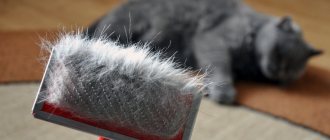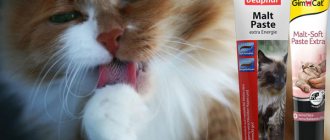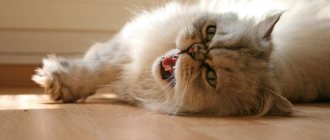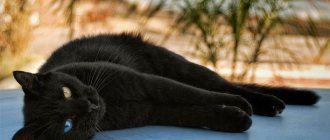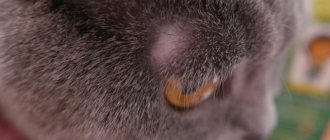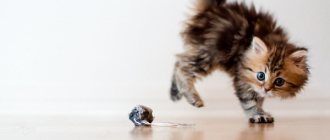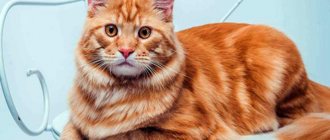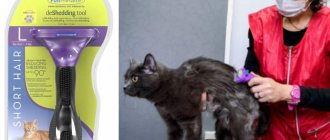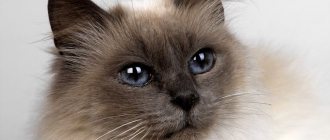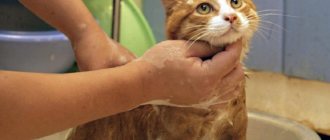In fact, cat fur is a hair coat that is a derivative of the epidermis. There are different types of fur: thin, thick, soft like down and hard like bristles, straight or curly. Despite such differences, it is important to care for long-haired and short-haired breeds regularly, otherwise the condition of the coat will worsen, in addition, the risk of developing various dermatological pathologies, which are not easy to deal with, will increase.
Types of hair in cats and description
Coat types, which are an individual feature of the breed, are classified based on the length, thickness and structure of the hairs.
In addition, the specific combination of guard hair, guard hair, and undercoat is determined. Based on this criterion, the following types of cat hair are distinguished:
- Undercoat. This is soft, fluffy fur, the main function of which is thermal insulation. It is the presence of undercoat on the body that provides the animal with reliable protection from the cold in winter and from the heat in summer. If you do not take care of the coat and comb it in a timely manner, this layer becomes tangled. The animal looks unkempt and sheds heavily. However, some breeds, such as Orientals, have no downy hair at all.
- Guard hair. Forms a middle covering layer. At the base the hair is thinner, and at the tip it thickens. The structure and size vary depending on the individual characteristics of the variety. One species has guard and guard hairs of the same length; in others, the guard may be shorter.
- Protective. It differs from other types in that it has a rigid structure that protects the animal’s body from getting wet. The hairs are wider from the base, but gradually narrow towards the tip. It is this type of cat fur that determines the main color.
- Pooh. Grows in kittens and sphinxes. The hairs are very thin, sparse, and difficult to distinguish in adult representatives.
- Vibrissae. They are long whisker hairs that take an important part in the life of the animal. Whiskers are located on both sides of the muzzle, above the eyes and on the outside of the lower leg. It is forbidden to cut off tactile hair, because without it the animal will not be able to fully receive signals from the outside world and fully communicate with its relatives.
What is a cat's fur: hair types
In cats, like in all mammals, scientists distinguish two main types of hair:
• Guard hair – straight, dense, strong, hard and long hair that protects the animal from external influences (sun, moisture, injury, etc.) and sets its main color. It is also the spine that has the ability to stand up “on end” if the cat is cold or if it is irritated.
• Downy (undercoat) – crimped, thin, soft and short hair that performs the function of thermoregulation (protection from cold)
However, in many cat breed standards you can see the terms “top coat” and “down” - these are already subtypes of hair and undercoat, respectively:
• Top (guide) hair is the hardest and longest hair, usually located along the cat's spine from the withers to the tip of the tail and has water-repellent properties.
• Down is a very short and soft undercoat found on Sphynxes and some rexes.
Hair in cats grows in tufts: from the central primary follicle - the guide hair, from two lateral primary follicles - the spine, and from 15-30 secondary follicles surrounding the primary ones - the undercoat.
A special type of cat hair is vibrissae. Vibrissae are hard, dense and long tactile mechanosensitive hairs (in cats these are “whiskers”, “eyebrows”, as well as special hairs on the wrists). The vibrissae follicle is located deeper than the hair and undercoat follicles and is surrounded by nerve endings. With the help of whiskers, the cat senses air currents and can hunt and overcome obstacles in complete darkness.
The felinological term “adorning hair” is not a special type of hair, but a term intended to describe increased hair growth on certain parts of the body, which, theoretically, is not due to natural necessity. Decorating hair includes: tassels on the ears, collars, shirtfronts and panties.
How is color formed?
The main component of all cat colors is two basic colors: orange and black.
There are 2 main basic cat colors:
- black;
- orange or red.
It is these colors that are the main component of the various shades. Most colors are characteristic of purebred and outbred felines. However, breeders, during complex selective work, were able to ensure that only a certain variety could have a certain color, for example, pure white.
Fur length
The following types of breeds are distinguished depending on the length of the hair:
- Naked. This variety was not specially bred, and the main reason for the lack of hair is a gene mutation. If both parents are bald, the kittens that are born will also have no hair. However, there is still a small amount of fine hairs on the skin that are not able to protect the animal from the cold.
- Short-haired. This species has fur that does not exceed 5 cm in size. Despite the fact that the hair is thick, it does not require special care. It is enough to scratch the animal 1-2 times a week with a special brush to get rid of lost hairs.
- Semi-longhaired. The variety has long hair, but the undercoat is not very thick and fluffy. The difference in fur length is most noticeable in winter and summer.
- Long-haired. This beautiful fluffy breed's fur grows no less than 10-12 cm. The animal requires special, careful care so that the fur coat shines, does not become disheveled and does not become covered with tangles. In addition, animals are prone to heavy shedding, which increases the risk of hair accumulation in the digestive organs.
Cat fur: nature did its best
In the process of evolution, a cat's coat has acquired a complex structure of follicles. The follicle can be compared to a pot filled with soil for a houseplant. The strength of the plant root (hair root) and its stem (visible part of the hair) depends on how good and strong the pot is, and how fertile the soil is.
Each follicle is adjacent to a sebaceous gland, which provides lubrication to the hair, as well as a fan-shaped muscle, which lifts the hair when necessary and allows our cats to raise their fur.
Guard and down hairs
From each follicle in cats, two types of hair grow - covert (awn) and secondary - downy hair. Guard hairs are long, straight, with a cone-shaped tip and can have different thicknesses, depending on which they are divided into hairs of the I, II, III and sometimes IV order.
The thickest and longest of them are called guides. They are spaced more sparingly, and their shafts protrude above the tops of hair of other categories. The stronger and smoother the guard hairs, the less pronounced the waviness of the coat.
Each guard hair is surrounded by downy hairs. This is shorter, thinner, usually wavy hair, with a poorly developed core or no core at all. Thus, in cats with a “wild” coat type, the hair grows in tufts, which, in turn, form complex groups of several tufts.
In the center there is a guide hair of the first order and 1–2 thinner guard hairs. On the sides of each of them grow 6–15 downy hairs. Since the follicles are located obliquely in the skin, the guard hairs always cover the down hairs, performing the function of protection from external influences. The quantitative ratio of guard hairs and undercoat depends on temperature conditions.
Difference from hair
All mammals, including humans, have hair on their bodies, the number and structure of which depends on their functional purpose.
The hair of animals has the ability to provide thermal insulation, which distinguishes it from humans.
When thick, thick hair grows all over the body, it is called fur. In cats, hair is called fur. Any type of hair, regardless of structure and other characteristics, grows from a follicle. In different areas, the hairs differ in structure and density. The main difference between human hair and animal hair is that the latter’s core of the hair follicle has the peculiarity of providing reliable thermal insulation. In humans, the composition of hair has the same structure, but in animals, hair consists of guard and integumentary hairs.
How long does seasonal molting last?
If you are scared by your kitten's long first molt, don't worry. This is due to complex processes of physiological maturation. Shedding in cats that can be called adults goes back to normal. On average it lasts a couple of months a year. Once in the spring, and again at the end of autumn. There may be minor time shifts in the schedule.
Usually short-haired pets fit into the schedule and timing of shedding. It’s more difficult with the fluffier ones. Persians or Maine Coons, after shedding their guard hairs, take a long time to get rid of the undercoat. They definitely won't be able to do it without your help. If you don't help them with their struggle, the consequences can be serious. From local tangles to completely matted fur.
Sometimes shedding in cats occurs unplanned or does not stop for a long time.
What building?
Hair consists of 2 parts: the hair follicle, located under the skin, and the shaft. In addition, each hair consists of 3 layers:
- Cuticle. Layered on top of each other, tightly connected keratin scales that form the top layer of hair. Dry and dull hair on a cat is a consequence of damage and separation of scales.
- Cortex. It is a cortical layer consisting of dead cells. In addition, the cortex contains a pigment that determines the main color of the animal.
- Brain matter. Provides nutrition to the cuticle and cortex.
Diseases of the coat
Causes and symptoms
If a cat’s fur coat has stopped shining and is getting into clumps, then there is a possibility of developing a disease in its body.
If the care of the cat’s fur is correct, the animal is healthy, then the fur coat is smooth, thick, and shiny. If not properly maintained, the hair can become tousled, tangled, and unattractive. Various diseases also affect the appearance of a fur coat, among which the following are common in cats:
- hormonal disorders;
- allergy;
- helminthiasis;
- fungal skin diseases;
- congenital disorders;
- weakened immunity;
- viral or bacterial infection;
- dysfunction of the sebaceous glands;
- liver diseases, in which, in addition to deterioration in the quality of the coat, the mucous membrane becomes yellow.
Other reasons:
- pregnancy;
- molt season;
- uncontrolled use of certain groups of drugs;
- stress;
- elderly age.
Symptoms of wool disease are:
Symptoms such as dandruff and itching indicate problems with the coat.
- Tarnishing and profuse hair loss.
- The hairs are constantly whipped into dense tangles and hang in icicles.
- Dandruff and inflammation appear on the skin on the right and left sides.
- Worried about itching, redness.
- Body temperature rises.
- The animal becomes lethargic and drowsy.
how much hair does a cat have
I am very worried, torn between children. Vanya has treatment, kindergarten, constant search for good treatment, information, trying to understand where and where. Makar is also having a hard time right now, he is undergoing rehabilitation, three weeks have already passed, and he is left alone. In the morning I take Vanya to the garden, go home to cook dinner, then immediately after Vanya, take Vanya to his grandmother 25 km away, go back for Makar, take him home to eat and immediately go to Elektrostal for treatment until 8 pm, at 8-9.30 we are home , dinner, wash everyone, put them to bed and fall exhausted. And then there is the husband, who also wants attention... and food. And he also runs around all day, only for work, and has breakfast at 9 pm, he simply doesn’t have time for the rest. In the evening he brings Vanya from his grandmother. And also classes with a speech therapist from Vanya and a teacher from Makar. Plus I was sick for a week and walked without a voice.
It's very difficult financially. I think many will understand me. I don’t buy anything for myself at all, I wanted to buy a bag, mine was torn to shreds, I went to get a bag - I saw Norwegian Omega and bye-bye at the pharmacy, instead of a bag we now have a jar of fish oil (what is it worth, like a jar of caviar?). Stress makes my hair come out in clumps, this never happened even after giving birth. The whole bath is covered in hair after washing, the comb is covered in hair, your hands are in your hair if you run it over your head. The skin on my hands is cracking, probably not enough vitamins. The body is simply in survival mode. I went broke and bought myself vitamins, it’s a shame to go bald. And in my heart the cats are scratching, it would be better to put it aside for Vanka’s examination, ahead of the ultrasound and EEG of sleep. When will this all end? And yesterday the phone suddenly picked up and went off... forever. Sometimes I come to a rehabilitation center, see well-groomed mothers, and I really envy that they were able to live for themselves, and not for the child’s illness and its treatment. Well dressed, with manicure, with thoughts and conversations not about the disease (yes, there are few of them, but there are such mothers). I can’t let go of the situation, I can’t “forget” and just live in the present, without thinking about the future, I can’t spend money on myself when my children need help. Just a complex of sacrifice for the sake of others. As long as everyone is healthy, as long as everyone around is happy, and somehow I am. She promised Makar a water park during the holidays because he would do a good job in rehabilitation. And now I understand that there’s no way! And you think I'll let him down? No, I can’t, I’d rather infringe on myself or my husband in some way, because he tried so hard, he deserved it. What about me? It's okay, I'll endure it. I wonder how much longer I can stand this stress.
You don't have to write anything. I just needed to express it, there was no one else to tell me.
I want to go to the sea, to the gentle waves and warm sand.
What to do to restore hair?
If a cat has bad fur, it is first important to find out the reasons for the deterioration of its condition. To do this, you need to show your pet to a veterinarian and provide a detailed description of the cat’s condition. After the initial examination, the doctor will give a referral for a comprehensive diagnostic examination. Once the diagnosis is made, treatment is prescribed.
In addition to using the medication prescribed by your doctor, it is important to review your pet’s diet and add vitamins and nutrients to it. Proper care of a cat's fur is also important. The animal must be bathed periodically with special means. It is useful to comb 1-2 times a week, and if shedding occurs, it is recommended to comb the coat more thoroughly and repeat the procedure daily.
